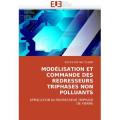Ph. D. THESIS
Modelling and control of three-phase rectifiers
operating at high efficiency and low total harmonic distorsion:
application to three-phase vienna rectifier
ABSTRACT
The problems of electric waveform quality constitute one of the major preoccupations of energy distributors and specialized organisms in power quality issues. This topic has gained more and more interest with the ascending use of power converters in almost industrial and domestic applications. In this thesis, the main interest is oriented to AC/DC converters, that adequate operation implies perfect regulation of the DC bus voltage, attenuation of current harmonic emission levels, compensation of reactive power and maximization of energetical efficiency. These different criteria should be maintained for diverse operating conditions, i.e. independently of parametric variations to which the system may be subject. It is, therefore, necessary to adopt efficient control techniques, which imperatively requires a correct modeling of the converter.
First, an experimental platform is put in place for the practical validation of the proposed theoretical concept. For this aim, we have designed and developed a 1.5 kVA three-phase power factor correction switched-mode rectifier, feeding purely resistive loads. A comparative study of different PFC-SMR topologies incited us to choose the three-phase/level/switch rectifier, commonly known as "Vienna converter". The choice of such a topology has been motivated by its advantages point of view simplicity of circuitry, high efficiency and very good performance in power factor correction. The proposed design approach is general, and may be adapted to higher rated power prototypes.
The second step consists of characterizing the most precisely possible the converter dynamics. The averaging technique is, therefore, used to develop the state-space model of the converter. The resulting model presents important variations into time, thus being hard to exploit for control design purposes. An adequate transformation of duty cycles, added to th expression of instantaneous state variables in the synchronous reference frame dqo allow overcoming this inconvenience. After that, the obtained averaged model is used to derive both static model (at the nominal operating point) and the small-signal model. These different converter models are validated in real-time on the experimental prototype, by means of the controller board DS 1104 of dSPACE® supported by the environment Real-Time Workshop of Matlab. The validation tools of the large-signal model are based on the analysis of phase-plane trajectories and time responses. Regarding the frequency model, we have used the famous small perturbation technique and the Bode diagrams.
Once the reliability of the proposed models is proved, we proceed to the design of control schemes. In this context, two avenues are possible: the use of linear control techniques based on the linear time invariant version of the converter model, or the use of nonlinear control technique based on the averaged model of the converter. Regarding the first approach, we opted for the study of a new concept, which is the quasi-linear control. This technique presents several advantages, such as its simplicity of design and implementation, but presents also the same limitations as other linear techniques in controlling nonlinear systems. The latter are especially put into evidence during severe perturbations regimes. Nonlinear and nonlinear adaptive control strategies are, then, proposed thus improving the transient dynamics of the system.
The synthesis of the different proposed control schemes leads to conclude that the nonlinear techniques are definitely the most robust face to various disturbances. Hence, they prove to request a high sensing effort. Consequently, the optimization of the sensors number in the experimental circuit appears as a new preoccupation to take into account. The proposed solution is the numerical reconstruction of the converter AC and DC voltages, using an extended Kalman filter as nonlinear observer. The estimated variables are, thereafter, used instead of their measured counterparts to re-implement the nonlinear control scheme. The obtained results are very satisfactory. An overview of the thesis is presented here  PhD_presentation _english.pdf
PhD_presentation _english.pdf
A copy of this thesis is available at:
http://proquest.umi.com/pqdwebdid=1467893061&sid=1&Fmt=2&clientId=46962&RQT=309&VName=PQD
The almost content of the thesis is presented in the book, edited by the Editions Universitaires Européennes:
http://www.amazon.com/MOD%C3%89LISATION-COMMANDE-REDRESSEURS-TRIPHAS%C3%89S-POLLUANTS/dp/6131509735
